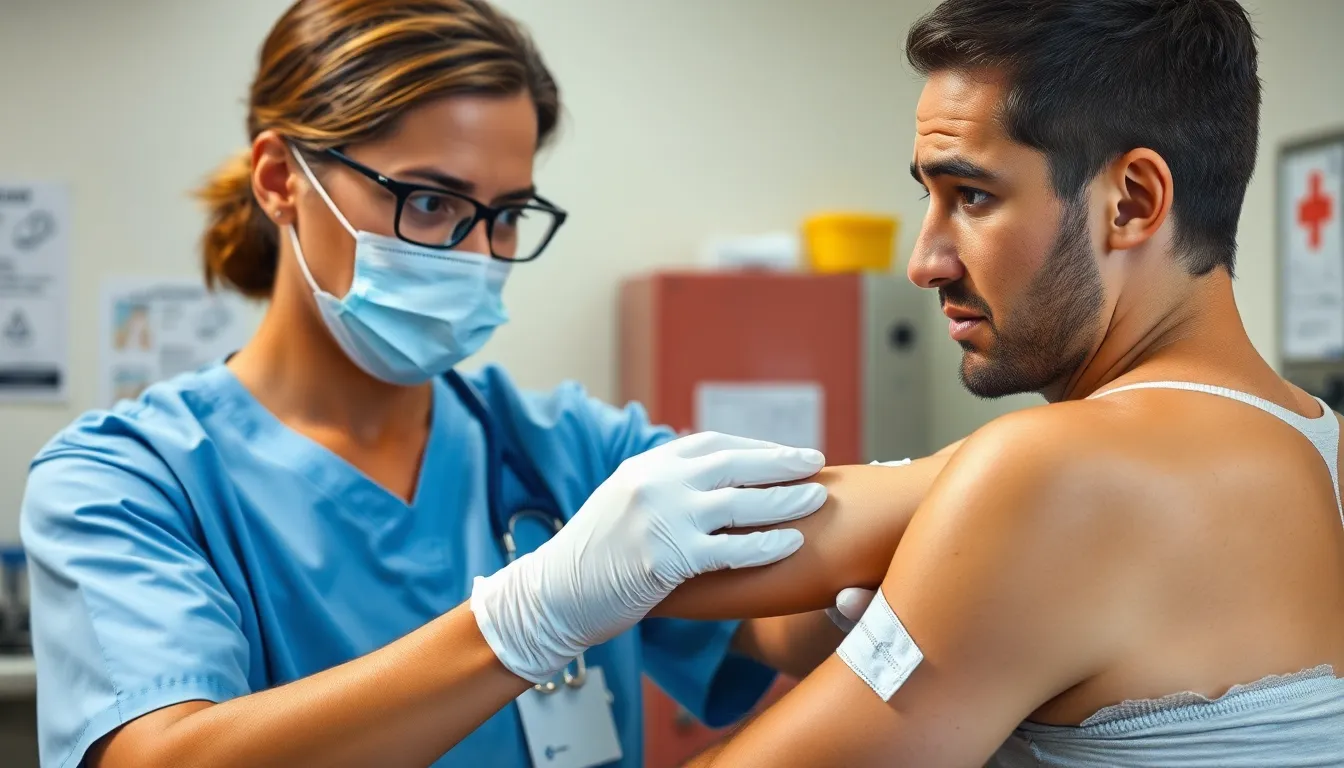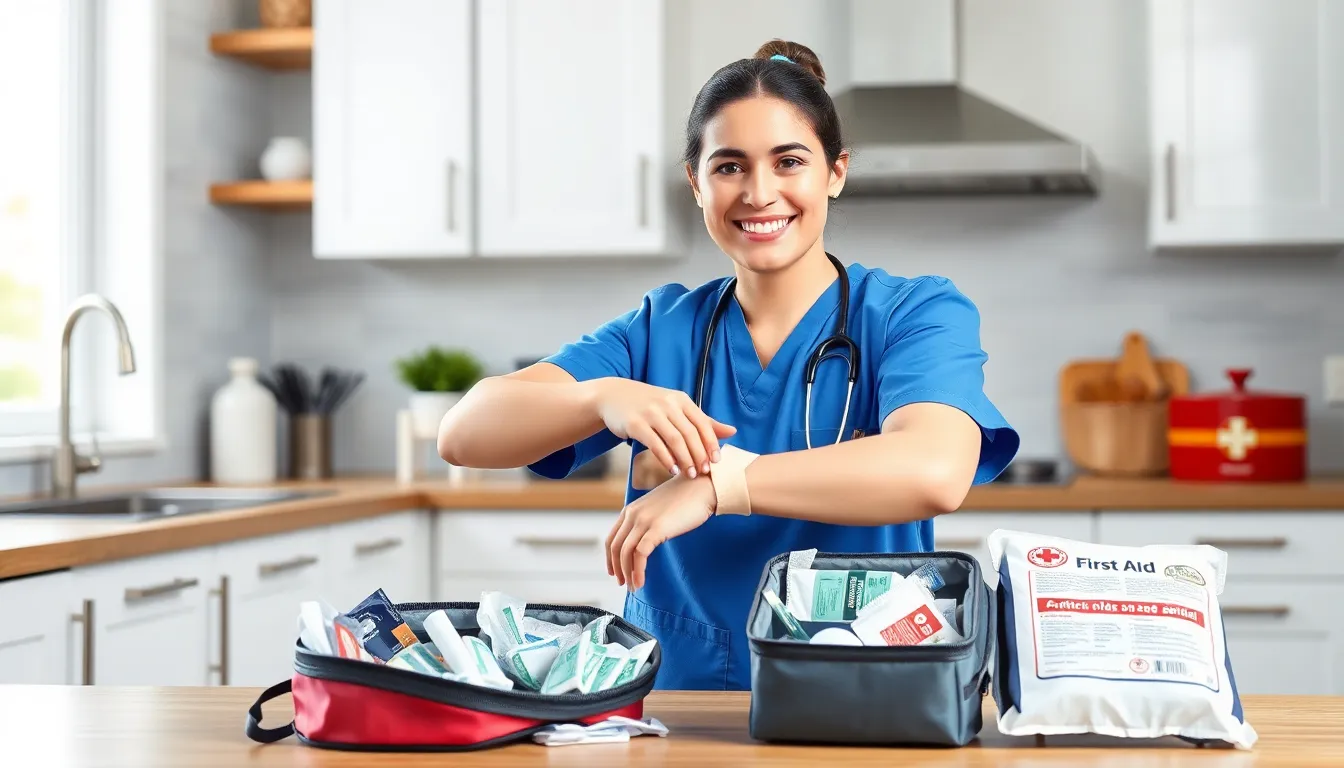When life throws a curveball and a wound appears, knowing how to handle it can make all the difference. Emergency wound care isn’t just for the brave souls in scrubs; it’s for everyone. Whether it’s a paper cut or a more serious injury, understanding the basics can turn a potential disaster into a minor inconvenience.
Imagine a world where you don’t panic at the sight of blood. With a few simple techniques and a dash of humor, you can become the hero of your own story. Let’s face it, nobody wants to be the one who faints at the sight of a band-aid. So buckle up and get ready to dive into the essentials of emergency wound care. It’s time to equip yourself with the knowledge that could save the day—because who wouldn’t want to be the calm in the storm?
Table of Contents
ToggleUnderstanding Emergency Wound Care
Emergency wound care plays a crucial role in injury management. Individuals equipped with basic wound care knowledge contribute to efficient responses in critical situations.
Importance of Immediate Treatment
Immediate treatment minimizes complications and promotes healing. Delaying care for wounds increases the risk of infection and further injury. Promptly addressing a wound helps control bleeding, which can be life-threatening in severe cases. Applying direct pressure to a wound immediately after the injury can stop excessive blood loss. Additionally, timely treatment reduces pain and anxiety for the injured person. Regularly assessing the wound ensures appropriate care and prevents worsening conditions.
Types of Wounds Requiring Emergency Care
Several wounds necessitate urgent medical attention. Deep lacerations that expose muscle or bone require immediate evaluation. Puncture wounds, especially those from animal bites or dirty objects, pose a high risk of infection. Burns classified as second-degree or higher demand emergency care due to potential tissue damage. Gunshot wounds also require urgent intervention, as they can cause profound internal injuries. Finally, wounds involving severe bleeding, regardless of type, merit immediate attention to prevent shock and other life-threatening complications.
Initial Assessment of Wounds

Initial assessment of wounds is crucial for effective emergency care. Recognizing the wound’s severity and type helps determine the appropriate treatment steps.
Identifying Severity and Type
Identify the wound’s severity and type to ensure effective treatment. Assess whether a wound is superficial or deep, closed or open. Look for signs of severe bleeding, exposed tissues, or foreign objects. Puncture wounds or lacerations often require different handling techniques. Consider the injury’s cause as well; for instance, bites may carry infection risks. Previous medical history might contribute to deciding the urgency of care. Take note of alerts like significant swelling or signs of infection. These factors guide the decision on whether to seek professional medical help.
Essential Safety Precautions
Prioritize safety precautions during wound assessment and care. Wear disposable gloves if available to minimize the risk of infection. Use clean materials for treatment, such as sanitized dressings or bandages. Avoid touching the wound directly to reduce contamination chances. If the wound bleeds excessively, apply direct pressure to control bleeding initially. Maintain a calm environment to ease the injured person. Prepare for potential complications during care, such as shock or allergic reactions. Always consider the need for emergency medical services if the situation exceeds basic first aid capabilities.
Basic First Aid Techniques
Basic first aid techniques are essential for effective emergency wound care. Mastering these skills can make a significant difference in injury management.
Cleaning the Wound
Cleaning a wound properly promotes healing and prevents infection. Start by rinsing the affected area under clean, running water. Use mild soap to gently clean around the wound, avoiding harsh chemicals. After rinsing, pat the area dry with a clean cloth or sterile gauze. Assess the wound for debris and any signs of serious injury. If dirt or foreign objects remain, remove them carefully with sterile tweezers. Avoid scrubbing the wound, as this can cause further damage.
Applying Dressings and Bandages
Applying dressings and bandages protects the wound and aids in healing. Select an appropriate dressing based on the wound type; sterile adhesive bandages work well for minor cuts. For larger or deeper wounds, use sterile gauze pads secured with tape or a bandage. Cover the wound completely, ensuring no exposed areas remain. Change the dressing regularly, particularly if it becomes wet or dirty. Keeping the wound clean and covered reduces the risk of infection.
Controlling Bleeding
Controlling bleeding is crucial in wound care. First, apply direct pressure to the wound using a clean cloth or bandage. Maintain pressure for several minutes without lifting to check for bleeding. If bleeding continues, add more layers rather than removing the initial cloth. Elevating the affected area can help reduce blood flow. If bleeding is severe and does not stop with pressure, seek emergency medical help immediately. Understanding these steps can save lives in critical situations.
When to Seek Professional Help
Recognizing when to seek professional help is crucial for effective wound management. Several indicators signal the need for medical attention.
Signs of Infection
Infection manifests through specific symptoms. Increased redness around the wound often indicates infection. Swelling and warmth may also occur in the affected area. Moreover, pus or drainage from the wound suggests a bacterial presence. Persistent pain, worsening over time, raises further concerns. Fever can develop, indicating the body’s systemic response to infection. Seeking medical help upon noticing these signs prevents complications and promotes timely treatment.
Complications That May Arise
Complications can develop from untreated wounds. Severe bleeding poses the immediate risk of shock and can be life-threatening. Additionally, non-healing wounds may lead to chronic pain and longer recovery times. Deep puncture wounds carry the potential for organ damage, necessitating professional evaluation. Tetanus infection arises from dirty or contaminated wounds, requiring immediate intervention. In some cases, bone infections can occur, leading to serious systemic issues. Awareness of these risks highlights the importance of timely medical consultation for effective wound care.
Emergency Wound Care Supplies
Essential supplies for emergency wound care ensure quick and effective treatment. Having the right items readily available can significantly impact outcomes during critical moments.
Essential Items for First Aid Kits
First aid kits must include adhesive bandages in various sizes for minor cuts and abrasions. Sterile gauze pads support larger wounds while adhesive tape secures them in place. Antiseptic wipes eliminate bacteria, reducing infection risks. Tweezers assist in removing splinters or foreign materials. Disposable gloves protect caregivers and maintain hygiene. Scissors help cut gauze or clothing when necessary. Pain relievers like ibuprofen or acetaminophen manage discomfort.
Recommended Products for Home Use
Using high-quality hydrogen peroxide or antiseptic solution effectively cleans wounds at home. Medical-grade adhesive bandages promote healing by keeping wounds protected. Incorporating a digital thermometer in home kits aids in assessing fever linked to infection. Sterile saline solution safely rinses eyes or wounds. Elastic bandages provide support for sprains or strains. Regularly reviewing and restocking supplies guarantees readiness for emergencies.
Emergency wound care is a vital skill that everyone can learn. By equipping themselves with basic knowledge and supplies, individuals can confidently manage injuries and respond effectively in critical situations. Recognizing the severity of a wound and knowing when to seek professional help can make all the difference in outcomes.
Maintaining a well-stocked first aid kit ensures readiness for any emergency. With the right approach and mindset, anyone can become the hero in their own story, capable of handling wounds with poise and efficiency. Embracing these skills not only fosters personal safety but also empowers others in the community.



